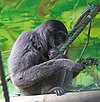The World's 25 Most Endangered Primates
[3] That same year, the list began to provide information about each species, including their conservation status and the threats they face in the wild.
[1] The purpose of the list, according to Russell Mittermeier, the president of CI, is "to highlight those [primate species] that are most at risk, to attract the attention of the public, to stimulate national governments to do more, and especially to find the resources to implement desperately needed conservation measures.
"[10] Species are selected for the list based on two primary reasons: extremely small population sizes and very rapid drops in numbers.
These reasons are heavily influenced by habitat loss and hunting, the two greatest threats primates face.
With the publication of the 2006–2008 list, four species were removed because of increased conservation efforts: the black lion tamarin (Leontopithecus chrysopygus), golden lion tamarin (Leontopithecus rosalia), mountain gorilla (Gorilla beringei beringei), and Perrier's sifaka (Propithecus perrieri).
[10] The Hainan black crested gibbon (Nomascus hainanus), which was removed from the 2008–2010 list, still has fewer than 20 individuals left, but significant efforts to protect it are now being made.
[2] With the exception of the 2000–2002 publication, which was written collaboratively by the IUCN/SSC PSG and CI, the list has been revised every two years following the biannual Congress of the IPS.




















































